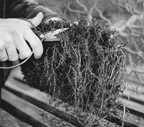Botany Basics - Part 3:
The Root System

The underground parts of plants receive scant attention from gardeners, kind of “out of sight, out of mind”. Only when a plant is root bound and is to be transplanted do most gardeners suddenly become aware of the root system. It is designed by nature to do three things. Roots anchor the plant in the soil, absorb water and nutrients and store excess food for future needs.
Roots anchor the plant in one of two ways or sometimes by a combination of the two. The first is to occupy a large volume of shallow soil around the plants base with a fibrous (diffuse) root system, one consisting of many thin, profusely branched roots. Since they grow relatively close to the soil surface, they effectively control soil erosion. Fibrous roots capture water as it begins to percolate into the ground and must draw their mineral supplies from the surface soil before the nutrients are leached to lower levels.
A tap root system sends one or two rapidly growing, sparsely branched roots straight down into the soil to draw from deep water tables and mineral supplies. A few species simultaneously grow both root systems, others adopt one form or the other, depending on soil/water conditions. Fibrous roots when the surface soil is moist, tap roots when it is dry. Although roots of most trees grow to moderate lengths, they rarely exceed the height of the tree.
Trees distribute their roots in a wide circle where water absorbing root tips occupy a “drip zone”, an area beyond the leaf canopy where rain is channeled from the foliage above.
Because the main purpose of roots is to probe the soil for water and minerals at a distance from the plant, primary growth is their most important growth process. Most new cells produced are laid down behind the growing tip. There, they augment the length of the root and when the cells elongate , the root tip pushes its way through the soil with considerable force. To protect the tip, the root produces cells ahead of itself forming a root cap. Root cap cells are readily rubbed off, but are quickly replaced from within, much like our skin when it dries and peels off from the surface. When root cap cells are ruptured by sharp soil particles, their protoplasm forms a slimy coat lubricating the root tip as it works its way through the soil and around large objects. All of the root’s primary growth activity is concentrated about 1/4” along its tip.
Water absorption takes place a short distance back in an area where a fuzzy band appears around the root. This band is formed by thousands of projecting root hairs. Root hairs are extensions of the outer root cells and increase, several hundred fold, the organs absorptive surface area. The width of the root hair zone remains constant. During continued root growth, new hairs form just above the growing tip, while old ones, at the top of the group, shrivel and die.
Branching begins in the slightly older root sections, some distance from the tip. Branch roots originate deep inside the parent root and tend to grow at right angles to it, better to explore other regions of soil around the plant. Each branch is an exact duplicate of the root that produced it, with the same methods of growth, a set of root hairs and the capacity to form branches of its own.
When a root tip comes in contact with air, the root cap cells harden and the root stops growing in length. To prevent roots from growing upwards the root cap contains a tiny ball of clay in its hollow end that gravity acts upon and keeps the root tip growing downward.
Please click on one of the links below:
